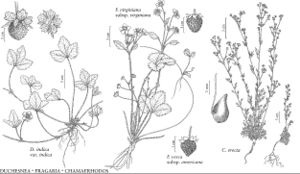Fragaria
Sp. Pl. 1: 494. 1753.
Gen. Pl. ed. 5, 218. 1754.
Herbs, perennial, acaulescent, 0.2–2.8 dm; short-rhizomatous, stoloniferous. Stems 1–10 (crowns), procumbent, sympodially branched, stolons not leafy, rooting and producing shoots at every 2d node, glabrate to densely spreading-hairy or appressed-ascending hairy. Leaves deciduous, basal, alternate, ternate; stipules persistent, basally adnate to petiole, lanceolate, margins entire; petiole present; blade shallowly deltate to widely ovate or widely depressed ovate, 1–6 cm, thin to thick, sometimes leathery, leaflets 3, usually ovate to obovate, sometimes rhombic to roundish, margins flat, serrate to crenate, venation pinnate, abaxial surface sericeous (at least along veins), adaxial mostly glabrate. Inflorescences axillary from leaf rosette, 1–10-flowered, cymes, glabrate to densely spreading-hairy or appressed-ascending-hairy; bracts usually present; bracteoles present, caducous. Pedicels present. Flowers bisexual or unisexual (plants synoecious, gynodioecious, dioecious, or trioecious), 12–29.8 mm diam.; epicalyx bractlets 5; hypanthium saucer-shaped, 9.5–27.8 mm diam., hairy; sepals 5, spreading, broadly lanceolate; petals 5 [–9], usually white, rarely pink, orbiculate to ovate or obovate, base clawed; sterile staminodia in pistillate flowers; stamens 15 in 3 whorls, shorter than petals, anther thecae 2; torus globose to conic; carpels 30–150, glabrous, styles basal; ovule 1. Fruits accessory; aggregated achenes, 30 (or less) –150, borne on enlarged torus, superficial or embedded in torus flesh, ovate or ± ovoid, 1–2 mm, glabrous; torus usually red, wine red, or carmine, rarely white, globose or subglobose to oblong, conic, or oblate, 9–24 (–37) mm, fleshy, apex sometimes pointed; hypanthium persistent; sepals persistent, spreading, reflexed, or clasping tori; styles deciduous. x = 7.
Distribution
North America, Mexico, South America, Eurasia, Pacific Islands (Hawaii), nearly worldwide
Discussion
Species 24 (3 in the flora).
The marginal teeth on terminal leaflets vary in size and number depending on length of the terminal leaflet in the species of Fragaria. The following ratios are used in the keys and descriptions: relative size of teeth (length in mm of terminal leaflet to number of teeth per side) and relative number of teeth (number of teeth per side to length in mm of terminal leaflet). The length to width ratio of leaflets is also given.
Fragaria belongs to subtribe Fragariinae (D. Potter et al. 2007), which is generally characterized by stamens with a single horseshoe-shaped theca (T. Eriksson et al. 2003), and includes, in the flora area, Alchemilla, Aphanes, Chamaerhodos, Comarum, Dasiphora, Drymocallis, Sibbaldia, and Sibbaldiopsis.
Hybrids:
Fragaria ×ananassa Duchesne ex Rozier subsp. ananassa [Fragaria chiloensis (Linnaeus) Miller var. ananassa (Duchesne ex Rozier) L. H. Bailey], the garden or dessert strawberry (2n = 56). Fragaria ×ananassa originated under cultivation in Europe from crossings of the cultivated F. chiloensis forma chiloensis and F. virginiana. It is grown today on all continents and occasionally escapes from gardens.
Fragaria ×ananassa Duchesne ex Rozier subsp. cuneifolia (Nuttall ex Howell) Staudt [Fragaria cuneifolia Nuttall ex Howell; F. ×ananassa var. cuneifolia (Nuttall ex Howell) Staudt)]
Stolons spreading or appressed ascending-hairy. Leaves dark green to bluish green, slightly glaucous, sometimes dull, ± thin to ± thick, sometimes leathery, abaxial surface mostly not strongly reticulately veined, adaxial glabrous, often shiny; petiole usually densely spreading-hairy (hairs sometimes descending or appressed); terminal leaflets petiolulate, margins serrate to crenate in distal 1/3, terminal tooth shorter than adjacent teeth. Flowers 14–19 (pistillate) mm diam., 17.2–24.9 (staminate or bisexual) mm diam. (plants dioecious, gynodioecious, or trioecious); hypanthium 14.3–23.8 mm diam.; petals round to oval, margins distinct or overlapping. Achenes in shallow pits or embedded, dark reddish brown to dark brown, 1.4–2 mm; bractlets and sepals clasping; torus yellowish red to red, globose, flattened, or conic, not easily separated from hypanthium. 2n = 56.
Subspecies cuneifolia arose in nature from taxa in western North America (G. Staudt 1962). Wild-growing, reciprocal hybrid populations between Fragaria chiloensis subsp. pacifica and F. virginiana subsp. glauca occur in coastal areas between Vancouver Island and Point Sur, California. These plants were recognized by T. J. Howell (1897–1903) as F. cuneifolia Nuttall and by Staudt (1999) as F. ×ananassa subsp. cuneifolia.
Fragaria ×bringhurstii Staudt. Leaves mostly intermediate in texture and hairiness; flowers unisexual, intermediate, usually sterile, sometimes partially fertile; fruits not observed.
Fragaria ×bringhurstii is difficult to differentiate from F. chiloensis and F. ×ananassa subsp. cuneifolia. It has been found at eight localities on the coast of California, in Humboldt, Marin, Monterey, San Mateo, and Sonoma counties. Its origin as hybrids of F. chiloensis and F. vesca subsp. californica can be deduced from its chromosome numbers (2n = 5x = 35, 2n = 6x = 42, and 2n = 9x = 63) and morphology. Reduced and unreduced gametes were involved in both species. Partial fertility and abnormal gamete production in the hybrids may give rise to plants with new chromosome numbers hitherto not known in nature.
Selected References
None.
Lower Taxa
Key
| 1 | Leaves thick, leathery, strongly reticulately veined abaxially; achenes 1.4–2 mm, reddish brown to dark brown; coastal w North America. | Fragaria chiloensis |
| 1 | Leaves thin, sometimes slightly leathery, not reticulately veined abaxially; achenes 1–1.8 mm, yellowish green to reddish brown; mostly inland North America, sometimes coastal | > 2 |
| 2 | Leaves thin, bright green (sometimes darker green in subsp. californica), not glaucous; terminal tooth of terminal leaflet usually longer than or equal to adjacent teeth (sometimes equal to or shorter than adjacent teeth in subsp. californica); achenes 1–1.5 mm; plants hermaphroditic (sometimes pistillate in subsp. bracteata). | Fragaria vesca |
| 2 | Leaves thin but ± stout (slightly thicker than F. vesca), sometimes slightly leathery, green to bluish green, sometimes bright green, sometimes glaucous; terminal tooth of terminal leaflet usually shorter than adjacent teeth; achenes 1.2–1.8 mm; plants hermaphroditic or unisexual. | Fragaria virginiana |
"thin" is not a number. "thick" is not a number.
